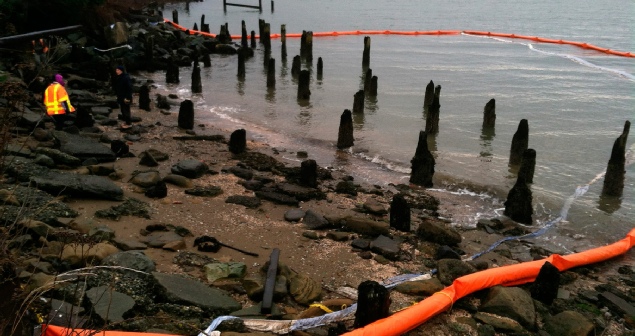
IEP - INTERNATIONAL ENVIRONMENTAL PRODUCTS, LLC


All rights reserved © International Environmental Products

WHAT IS BIOREMEDIATION?
Bioremediation is the process of using naturally occurring, safe and beneficial micro organisms to degrade environmentally harmful contaminants and turn them into non-toxic compounds. In particular, these organisms will break down most petroleum hydrocarbons and transform them into carbon dioxide (C02) & water.
WHAT ARE THE ADVANTAGES OF BIOREMEDIATION?
Bioremediation is an attractive option for the remediation of hydrocarbon contaminants. The following are a few of the advantages & reasons why you should consider this innovative process and S200.
The process is an ecologically safe and natural process. It is “nature’s way” of solving contamination problems.
Bioremediation is cost effective. The process is generally 6O – 70% less costly than other technologies.
Little disruption of surrounding, non-contaminated areas.
Virtually no investment in “capital equipment”.
Can remediate areas that are not easily accessible or are inaccessible to other technologies.
Bioremediation can be accomplished in-place (In Situ) thereby eliminating the hazard of “off site contamination caused by digging, hauling and transporting contaminants to other areas.
Air quality and air pollution concerns from volatile chemical evaporation are eliminated.
After bioremediation is completed, the environment is virtually restored to its pristine condition.
The process poses no health or safety risks to your employees thereby reducing insurance costs.
WHY IS S200 THE BEST HYDROCARBON REMEDIATION TOOL ON THE MARKET?
S200 can be used on the shorelines and waters of the US. There is no addition of ‘foreign bacteria’ to the ecosystem. Unlike other remediation products, our products require no special solutions, no special mixing and no waiting period before application. The simple act of spraying S200 to the hydrocarbon spill or leak activates the product and starts growing the indigenous, hydrocarbon degrading bacteria population. S200 is easy to use and therefore require very little training of personnel. All of these factors translate into cost savings for the user. S200 was developed to bring the innovative technology of bioremediation into everyday use. It is the only technology needed to solve your hydrocarbon contamination problems from the past and prevent those problems in the future.
WHAT HAPPENS IF I ADD MORE S200 THAN NEEDED FOR MY SITE?
The ratio of S200 to be used in your site will depend on the quantity of hydrocarbon you have. The theoretical relation between C:N:P is 120:10:1. In the laboratory, and with optimal conditions for bioremediation, you will have to add 1 Kg of S200 per 1 Kg of hydrocarbon contaminant. This 1:1 ratio can be increased if the conditions are not optimal. Nevertheless, if you apply more nothing bad will happen, as the fatty acid outer shell will protect the nutrients until it is attached to new contaminant.
COULD THE N AND P PRESENT IN THE PRODUCT CREATE AN ALGAE BOOM?
The excess quantity needed to create an algae boom is more than 10 times your suggested quantity. We have never seen an algae boom with S200.
WHAT ANALYTICAL METHODOLOGY SHOULD I USED TO DETERMINE THE BIODEGRADATION RATE?
You can use any analytical method you have been using up to now. There is no need to use a specific one. TPH is a test to determine the total petroleum hydrocarbon in the sample. The gas chromatograph mass spectrograph determines the constituents in the TPH. With the GC data you can determine what is degradable and what is not. Such as very heavy asphalts (road tar). We use the standard GCMS test criteria for Diesel or DRO (Diesel range organics). If you are looking for gasoline you then use the GRO (gasoline range organics) criteria.
The best way to determine the biodegradation rate is to use TPH. The use of reference levels between different types of hydrocarbon such as aromatics or aliphatic versus asphalteens is not recommended as the bacteria can degraded asphalteens and convert them into aliphatics or aromatics.
WILL S200 WORK ON CHLORINATED CONTAMINANTS?
S200 is an oleophilic fertilizer; therefore it will attach to the hydrocarbons and stimulates hydrocarbon microorganisms. Normally the bacteria that eat hydrocarbon are aerobic, therefore they need oxygen to live. What happens with Chlorinated contaminants is that they do not biodegrade in an aerobic state and only degrade if the environment is anaerobic. We do not know of any microorganism that biodegrades Chlorinated hydrocarbons anaerobically at a reasonable rate, but if you have these organisms in the contaminated area, S200 will work the same way as for aerobic bacteria.
WILL THE PRODUCT AFFECT THE ENVIRONMENT IN ANY WAY?
S200 is 100% biodegradable; nothing will be left after the decontamination of the site. We have successfully passed very deep and detail tests for toxicology on fresh and salt water.
CAN I USE S200 AFTER USING A SVE OR MPE SYSTEMS?
Not only you can use S200 after using another physical method, but you can use it at the same time. S200 will stimulate the bacteria present for the biodegradation of your contaminant while you can make physical extractions of the heavy contaminated zones (free product). You can also inject air with Air Sparing or SVE vacuum methods.
WILL S200 BIODEGRADED ASPHALTEENS?
YES! And not only in laboratory conditions. S200 has been roughly tested in the bioremediation of the Prestige Spill (Spain, 2002). After four months of 2 applications with S200, the product was able to bioremediate 100% of fuel #6 covering the rocky shore. This was tested and concluded by Dr. Miguel Angel Murado from the Spanish Governmental Scientific Institution “CSIC-IIM of Vigo”
CAN S200 BE USED WITH PEROXIDES?
S200 can be used with any other technology that creates better environmental conditions for biodegradation. For low contaminated areas the oxygen dissolved in water or present in the soil could be enough. For heavy contaminated areas the use of physical or chemical oxygenating methods are always a plus.
WHAT KIND OF BACTERIA GROW WHEN WE APPLY S200?
S200 will stimulate specific hydrocarbon eating microorganisms. S200 will activate the indigenous microorganisms which can vary depending on the site and conditions. Our experience has shown that in winter and summer the type of microorganisms are different; in each season the most adapted for that climate are present in larger populations. With S200 not only one specific bacterium grows, but a wide range of hydrocarbon digesters. This consortium also makes different hydrocarbon chains degradable and together creates the right mix to biodegraded all the contaminant present.
CAN S200 BE INJECTED THROUGH THE MONITORING WELLS?
Depending on the porosity of the soil, S200 can be injected to groundwater through infiltration bands, or monitoring wells. If needed, S200 can be dissolved with water to facilitate the infiltration of the product.
WILL S200 CHANGE THE PH OF THE AQUIFER?
S200 has a pH between 6.8 and 7.0 and will not change the pH of the groundwater.
WHAT IS THE RADIUS OF INFLUENCE OF S200?
If a project site has slow groundwater flow, the radius of S200 application point will be wide and in all directions. S200 will disperse in the water column and only physical barriers could reduce its spread through the area. A very fast moving aquifer will result in a narrow band of S200 moving down gradient with less lateral spreading. If we have doubts on the radius of influence it can achieve on a certain site, you can mix S200 with water (x2 or x4) in order to get a better dispersion of the product.
ARE THERE ANY DISPOSAL ISSUES WITH THE SPENT S200?
S200 is a 100% biodegradable liquid product that is applied in the soil or water. You will not have any disposal waste.
HOW MUCH N AND P WILL S200 PROVIDE?
The optimum ratio for biodegradation is 120:10:1 (C:N:P). Using the recommended ration of S200 to the biodegradable hydrocarbon, you are applying the nitrogen compounds and phosphate compounds necessary to reach this ratio in conjunction with the hydrocarbon contaminant.
HOW LONG WILL IT TAKE FOR S200 TO CLEAN UP MY SITE?
We estimate that, in general, S200 increase biodegradation rates by 10x to 50x depending on the hydrocarbon. However, the duration of the cleanup is very difficult to predict with accuracy due to uncertainty about type of micro organisms present, mass of contaminant, temperature, etc... Bioremediation of hydrocarbon contaminants via S200 is a less costly, less intrusive, and a more organic remedial alternative that may take longer compared to an expensive, highly-engineered, physical or chemical treatment method with a well defined schedule.
WILL S200 DISSOLVE IN WATER?
S200 is totally miscible in water. You can dissolve S200 in non chlorate water to get a better dispersion of the product on soil or groundwater.
WHEN I APPLY S200 OVER CONTAMINATED WATER I SEE A LAYER ON THE SURFACE. IS THIS NORMAL?
When S200 gets in contact with the contaminant it adheres to it, agglomerates the material and creates a wax like gel. This gel floats on the surface of the water allowing the aerobic degradation of the hydrocarbon to occur.







Bioremedation

| S200 |
| Biodegradable Bilge Clear |
| S200 for Sheen Removal |